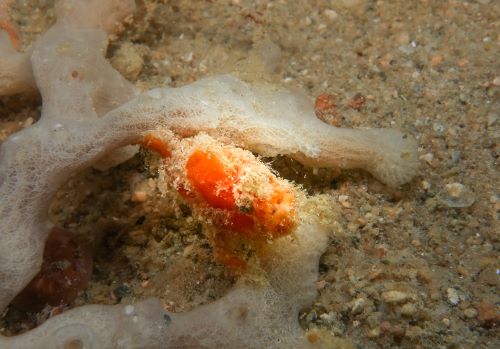Exploration Dive: Finding the Frogfish
A couple months back, my team and I went to Perhentian Island in Terengganu for a project called exploration dive. We were assisted by Mr Azharil Art from D’Lagoon Dive Centre, which was recommended by Mr Saiful Bahri Yakup, our team member who is a very well experienced diving instructor. We spent quite some time there with a few numbers of dive trip pursuing research related to marine life and the underwater environment. Nonetheless, this writing will only enumerate our work focusing on frogfish, including its behaviour, habitat, and species.
Frogfish, also known as anglerfish, falls under the family of Antennariidae. They are quite difficult to detect due to their ability to camouflage and blend in with the environment. However, they can be distinguished from other types of fish by dorsal-fin spines, lateral eyes, large mouth, and short compressed body. Unfortunately, little is known about frogfish, a unique underwater lie-in-wait predator that is often misunderstood. In fact, they get little interest among divers and aquarists because they are colourless, drab, and hardly move. However, as a cadre of frogfish grows within the dive community and aquarists, it helps people know frogfish better, which is fascinating.
Frogfish gets its food by using bait known as esca, which is equipped with its body. They lure other fish or prey using their fishing rod and hang the bait in front of their head, which is like how a fisherman uses a lure to catch fish. Once prey attracted to the bait, they will eat them by gulping water with its massive mouth. Their jaws are flexible enough to open more than 20 times their original with the sucking speed of 6 milliseconds. Since they do not have teeth, they would swallow the whole food. Even though they look like sponges and move slowly, they are known as animals with the fastest strike speed among other animals on the planet. In addition, they are also known as a carnivore, which also means they eat strictly only living things.
To discover a frogfish, we need to know where look for it. Frogfish can be found at the bottom of the shallow to midwater sea with a temperature of around 20 °C. They can also be found around coral reefs. However, more species are found to live close to reefs or on sand than in the coral reef itself, as shown in Figure 1.
(a)
(b)

Figure 1: Frogfish found (a) in water bottle, and (b) on sandy bottom
Other than that, frogfish can be found in the following places:
i. Garbage, wrecks, and artificial reefs: Garbage items such as tins, old cars, and bottles can be a great hiding place. Juvenile frogfish can be found living in this area.
ii. Outer reefs, exposed sponges: Giant frogfish can be found on barrel sponges or sometimes on anchoring ropes.
iii. Sandy reef flats with algae and seaweed: They shroud among algae and seaweed. Striped frogfish and hispid frogfish are among the species found here.
iv. Rubble in crevices beneath stones: The species are known to be very cryptic and can be found around or underneath the pieces of rubble.
v. Shallow water: Some frogfish species can be found in shallow water (less than 4-m depth), such as Randall’s frogfish and Histiophryne species.
vi. Coral reefs: They can be found between the corals, preferably near sponges, since plenty of sea creatures can be found here aside from good hiding spots. However, nowadays, they can also be found at wrecks and artificial reefs due to habitat loss.
In our findings, frogfish normally do not have many predators due to their ability to camouflage. Besides, if they feel threatened, they will scare the predators away by puffing up. The most popular predator known to frogfish is the moray eel, even though it is rare to see this animal attacking or eating a frogfish. As for us, we have not seen this event and really looking forward to it. Finally, I would like to thank the excellent guides who, with their skill and dedication, have helped me enormously to gather information and photos of frogfish.

The writer is a Senior Lecturer at the Faculty of Mechanical and Automotive Engineering Technology and the Head of Curriculum Centre, Universiti Malaysia Pahang (UMP).
By: Ts. Dr. Siti Rabiatull Aisha Idris
e-mail: rabiatull@ump.edu.my
- 319 views









